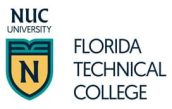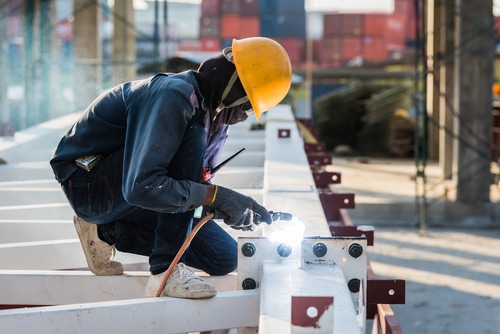Manufacturing and construction are booming and that means careers for skilled tradesmen and women are increasing as well. This is matched by an uptick in enrollment in schools that offer certificates, diplomas and degrees in career-oriented programs, like Florida Technical College and its welding training program. More young people—and adults making career changes—are choosing trade and career colleges over traditional universities.
What Does a Welder Do?
Welders, cutters, solderers, and brazers use hand-held and remotely controlled welding equipment to join and cut metal parts, and fill holes, indentations, or seams in metal products. According to the U.S. Bureau of Labor Statistics, work in a wide variety of industries including pipelines, power plants, manufacturing plants, automobile manufacturing and building construction using welding techniques like TIG welding, MIG welding, shielded metal arc welding, and flux core arc wielding. Welders, cutters, solderers, and brazers:
• Join and cut metal parts
• Study blueprints, renderings, sketches, or specs
• Calculate and measure the dimensions of parts to be welded
• Inspect structures or materials before welding
• Monitor the welding process to avoid overheating
• Maintain equipment and machinery
Welding Training at Florida Technical College
There are many different ways to weld, depending on the materials, thickness and cleanliness of the weld. Florida Technical College teaches the following welding techniques:
Shielded Metal Arc Welding (SMAW) – also known as stick welding. Although one of the easiest techniques to master, it doesn’t use shielding gas so it can be used outside. However, stick welding produces lower quality welds.
Flux Core Arc Welding (FCAW) – uses continuous wire fed electrodes, a welding power supply and welding equipment for shop fabrication, maintenance and shipbuilding.
Gas Metal Arc Welding (GMAW) – also known as MIG welding, this technique uses a thin wire as an electrode. As the wire heats up, the welding instrument moves it to the welding location on the metal. This technique is used with stainless steel, copper, nickel, carbon steel and aluminum.
Gas Tungsten Arc Welding (GTAW) – also know as TIG welding, this technique is used to weld together thin and non-ferrous materials. These materials include aluminum, copper, lead and nickel. This technique is considered one of the hardest to master but the final weld is extremely strong.
Are Welding Trade Schools Good?
So why should you choose welding training to launch your new career? Companies in the manufacturing and construction industries need all kinds of skilled workers, including welders. And, choosing a trade program over a four-year degree gives you plenty of advantages. You can get a career instead of a job and you can get it sooner; trade programs help you get into careers that are lucrative; and trade school is flexible and convenient so you can learn at your pace and on your schedule.
Welding Training Leads to a Career Sooner
One of the top reasons that people are choosing a trade like welding is that it leads to a real career much sooner than a four-year university program can. Even after finishing a four-year degree too many students find that their career options are limited, that the educational training they received was interesting, but not practical for employers.
In less than a year of studying and training in hands-on classrooms, you can be finished with your welding coursework and ready to be hired. You won’t have to worry that your educational training will be wasted. Welders and other skilled trade workers will always be in demand. If you have a family to support and you don’t have the luxury of taking four years to get an education, trade school are a good option.
Is Welder a Good Job?
If you choose a more traditional school instead, you will have to wait years to finally start earning. Skilled welders with proper learning are always needed, so they can always command competitive wages. As a welder you can make earning a good living more than just a possibility.
Trade School Lets You Work at Your Pace, on Your Schedule
Another reason that more students are choosing trades is that the training is much more compatible with the kinds of lives real adults live these days. Maybe you have a family and kids who need your time. Maybe you need to keep earning at your current job while you get your welding training done, so you can afford your rent and other bills.
Whatever is going on in your life, trade school as compared to a traditional four-year university, allows you to take courses on your schedule and finish your training at your pace. Most students at Florida Technical College can finish the welding training program in nine months, but if your life is complicated and you need more time, you can have it. Take as long as you need to get your education, or get it done quickly. The choice is up to you.
Enjoy the Comfort of Job Security
Welding as a career is growing every year. As construction continues to expand, especially here in Florida, skilled welders are needed. Because only skilled and trained individuals can do this job, your welding training puts you at an advantage over other job seekers.
Living paycheck to paycheck and never knowing whether you will be needed from one month to the next is no way to live. As a skilled worker you can finally enjoy better job security, yet another reason many people are turning to trades like welding. Technical and trade skills will always be needed and with the right training, you’ll be a step ahead of everyone else.
Trade schools are getting more popular as people begin to realize the many benefits of ditching traditional education: earning sooner, getting good job security, and just having a job that is meaningful and rewarding. If these benefits sound good to you, get your welding training started at Florida Technical College.
Welding Diploma Program
The Welding Diploma Program offers the technical and practical knowledge needed to interpret manufacturing and construction drawings, calculate measures, and bend, cut, grind, and weld ferrous and nonferrous metals. Students will learn shielded metal arc, gas metal arc, flux core arc, gas tungsten arc, and pipe welding.
Get more information about the Welding Diploma Program and learn how you could be off to a new career in just nine months.



